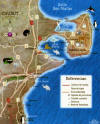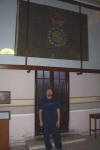Diary/Photo Journal
Week of April 24, 2005
We were delayed from leaving Puerto Madryn because of a persistent problem with Cindy that we have not been able to quite get a fix on, so to speak. We found a reasonable mechanic and by again taking apart the carburetor, we found a small internal gasket (that engages during acceleration) was shattered. Apparently, this was causing symptoms similar to having used bad gas in Cindy. A half a day later, Cindy was put back together and all seemed fine.
  |
View to Puerto Madryn across Golfo Nuevo |
  |
Historical monument - where the first Welsh settlers landed in 1886 Protest for higher wages |
While on our way to Puerto Piramides, within the Reserva Faunistica Peninsula Valdes, we felt Cindy was not quite right, yet again. She was starting and running without pause; however, she felt as though her engine timing was off and it was as though she were stuttering. By the time we pulled into Puerto Piramides, we realized that we had cured one ill and incurred another. Rather than punish Cindy with our planned excursion around the Peninsula Valdes, we found the town's lone mechanic and he diagnosed the problem almost immediately. It appears that we lost two cylinders out of eight (IE: we are running on six out of eight cylinders). Now, many of you think Gerson and I have always been running shy on the cylinders that we should, but poor Cindy does not function too well without all her facilities.
  |
Our sunset over Puerto Piramides |
|
You know you are in trouble when the tractor gets stuck in the sand Wait until the tide comes back in |
We came to the well-debated conclusion to return to Puerto Madryn and have Cindy's compression in her cylinders checked so we know for sure what we are up against. However, before we left this rather barren reserve, we hired a local man to drive us the 250 km around the peninsula for the opportunity to spot the rather infamous visitors.
I say infamous because we all have probably seen the National Geographic specials or any of the animal features that show Orcas or Killer Whales slamming onto a sandy beach, forcing a wave of water to dislodge the inexperienced sea lion pups along the shore. By dislodging the pups, this action rather gruesomely provides lunch for the Orcas as the pups cannot maneuver quick enough and are easily devoured by the Orcas. The Orcas attack predominantly at high tide, wherein they can swim over a rocky reef that protects the beach, and then easily claim their prizes.
We did not witness the violent, but natural, relationship between the Orcas and the sea lions; however, we did see several rather large Orcas prowling close to the beach during the high tide. As most of the sea lions have left for the winter and the pups are much more adept at avoiding the Orcas, the attacks were dwindling. According to the townspeople of Puerto Piramides, we were very fortunate to have witnessed any Orcas at all.
Even though the main attractions, the orcas and the penguins, were gone or nearly so, we were happily surprised to see some other critters running loose in the reserve.
  |
Only a face, body, feet, you name it, that a mother could love. Armadillos have hair! |
  |
A wily fox (zorro) looking for lunch These are penguin burrows |
Along with the animals, we witnessed some beautiful landscapes as we touched on the coastal cliffs now and again. Our pictures are somewhat devoid of people because it was difficult to have the animals stop and pose with us and the other pictures just came out better without us in them.
  |
The water color was a magnificent blue and so clear |
  |
Places where the
orcas come ashore There was an orca in the second picture and you can barely see the shadow under the water |
We enjoyed our jaunt around the peninsula and were glad we chose not to subject Cindy to the torturous road. Also, we feared being stuck somewhere out there when there was nothing anywhere. The peninsula is a vast open space and because it is past "season" everything was closed.
We made a stressful laden trip back into Puerto Madryn and headed straight for a mechanic that was recommended by the one in Puerto Piramides. Unfortunately, he did not want to touch Cindy but was nice enough to refer us to yet another mechanic. Gerson sang Cindy's woeful song of distress to this mechanic and even though he had several cars waiting for their turn of a wrench, he took pity on us and agreed to take a look at and a listen to Cindy.
We watched his facial expressions go from concern to amusement to frustration to questioning and all at once he looked up at Gerson and in Spanish said "There is nothing wrong with your cylinders". Gerson turns and gives me a look that I can only interpret as "What now?" and he tells me what was said. With the reduction of that huge weight, you could visibly notice the raising of our shoulders.
After a few turns, tweaks, and tightenings the mechanic found that our vacuum hose had been left unattached. Now, for those of you that do not know what this can do, it will cause the engine to stutter, backfire, stall, chug, ping - you name it, we had it. After a test drive up a punishing hill, Cindy performed marvelously and we again celebrated Cindy's resilience (especially to bad mechanics). Apparently, our last carburetor repair did not include resetting all the components correctly, including the vacuum hose *rolling eyes*.
So, to not curse us any further, the next morning we dashed off to Viedma/Carmen de Patagones, two towns that share the shoreline of the Rio Negro. The southern side, Viedma, is the northernmost city in Patagonia and Carmen de Patagones, is the southernmost city in the Province of Buenos Aires. Ahhh, the return to civilization.
Carmen de Patagones was of special interest to Gerson as this small and very poorly equipped city was able to repel an invasion from those nasty Brazilians in 1827. What was of such fascination to Gerson is that he had never heard of this "war" with Argentina. Now, Gerson is not without considerable formal education as well as he enjoys reading about history and other such events that have occurred in the world; however, this discovery at Carmen de Patagones surprised us and it just reinforces the fact that history is written by the victors and probably more often than not, much historic truth is withheld from the masses.
Inside the Templo Parroquial Nuestra Senora del Carmen church, one will find two of seven Brazilian flags captured during the war in 1827. As Gerson explained to me, in 1827, Brasil was ruled by Emperor Don Pedro II. As Brasil's history is storied, the King of Portugal avoided being captured by the notorious Napoleon when he fled to Brasil with his entourage. King Don Pedro I, sired a son and remained many years tucked away in the hot, humid, bug-infested Brasil. Missing the temperate Portugal, the King returned while his son, Don Pedro II, wished to remain in his "homeland" of Brasil.
Naming himself Emperor and emancipating himself from his parentage, Don Pedro II declared independence from Portugal in 1822. Five years later, he set forth upon a campaign against Argentina and as related above, was repelled by the people's of Carmen de Patagonia.
We pleasingly took advantage of a warm, sunny day and walked throughout the streets of Carmen de Patagones. But then, we did not have much choice as with all of Patagonia, they are very passionate about their "siesta" time and Patagonia literally shuts down between the hours of 2:00 pm to 5:00 pm. This is one thing about Patagonia that we just cannot and probably will not get used to...and that is the inability to visit museums, shops, restaurants or anything else during these hours as all such are closed, locked, abandoned and totally devoid of life. And, to make the adjustment completely out of our grasp, restaurants do not open for dinner until after 8:00 pm.
Now, when you camp outside of town and endure a one, two or three kilometer walk into town and you are hungry at 6:00 pm, a much more normal dinner time for us gringos (Gerson is an honorary gringo), waiting until 8ish for dinner is not within our stamina. As a result, we find ourselves wandering aimlessly, forlornly looking into restaurant windows, hoping that the establishment's managers will take pity on our pathetic souls and feed us prior to their "opening". Believe it or not, we have managed a few early meals this way. We are good at being pathetic!
Home Page South America Diary Index Previous Diary page SA Diary page 36
















